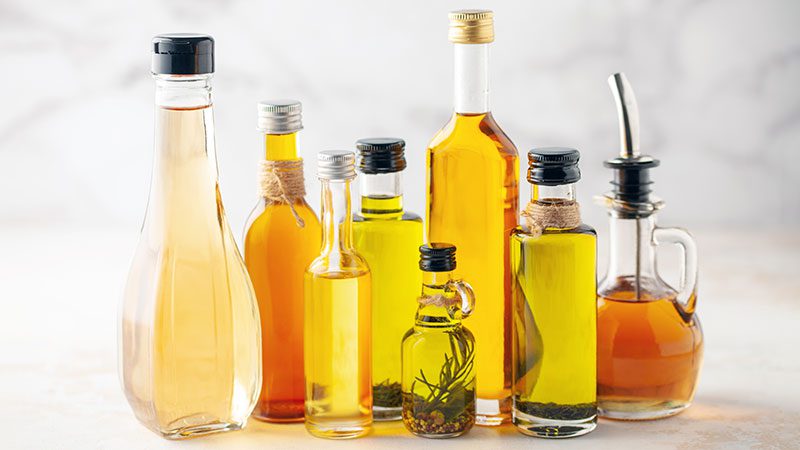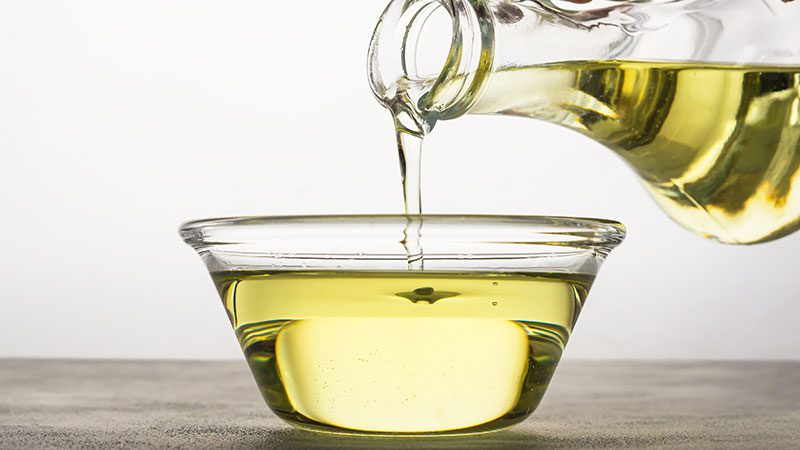The story of modern seed oils
By Rebecca Robinson

Many PCC members and shoppers are asking whether it is OK to eat and cook with seed oils. With questions and concerns on the rise, we are sharing what we have learned through our research over the past few years, and where PCC stands on products that contain seed oils. This article reviews the definition and history of seed oils. Look for part 2 in the May Sound Consumer on current claims about seed oil effects on health and their place in a wider discussion about overall health.
What is a seed oil?
Simply put, seed oils are exactly what they sound like — oils that are derived from the seeds of plants rather than from the fruits of plants. They include many common cooking oils and finishing oils used on foods. Although there are variations of which oils have drawn controversy in recent years, the most common ones are canola, grapeseed, sunflower, safflower, rice bran, cottonseed, soybean, and corn. These are widely used in cooking due to their neutral flavors and low smoke points. Olive oil, avocado oil and coconut oil are not seed oils, as they are produced from the fruits of their respective trees. Palm oil, while controversial for unrelated reasons, is also not a seed oil, it is produced by pressing the fruits of the trees. (However, palm kernel oil, which is produced by pressing the kernels of the palm fruit, is a seed oil.)
Are seed oils a new product?
Many argue that seed oils are a product of the modern industrialized world. That argument suggests the oils arose only in the early 1900s when companies started taking substances that humans could not otherwise eat and converting them to edible form. One example of this would be cottonseeds, which contain toxins that are dangerous to humans and many animals when unprocessed, but can be refined into edible oils.
There is some truth to that outlook when we look at modern oils that are mass-produced to accommodate a growing globalized population, and when we look at genetically engineered crops and advancements in chemical extraction methods and refinement.
However, basic seed oils have been part of human civilization for millennia. Archaeological evidence and written records indicate the practice of extracting oil from crops like soy, sesame, and sunflower for food preparation dates back thousands of years. Sesame oil played a large role in cultures and diets across the Middle East and India. Soy was a popular legume crop used for oil across Asia. Sunflowers were used by indigenous peoples in the Americas.
That being said, human diets and cuisines before the1900s were significantly more versatile than the modern Western diet. While sesame, soy, and sunflower oils were historically being used through the centuries, other oil and fat sources were also commonplace. Depending on the region, people used butter or lard from animals, and coconut or olive oil from fruits that grew on trees. It is also important to remember that processed foods with additives like fillers, stabilizers, gums, emulsifiers, artificial dyes and flavors, were not part of the human diet in that era.

How seed oils took over the modern diet
The rise of seed oils in our food is closely tied to how our food system has evolved over the past century. The push for fast and convenient meals, from the rise of supermarkets in the 1930s to the popularity of TV dinners after World War II (developed with technology used to feed soldiers C-rations), shaped the way we eat today. Vegetable (or seed) oils play an important role in that story, particularly with the shelf-stable, highly processed foods that started dominating traditional supermarket shelves in the 1980s.
The scientific advances that paved the way for many of these changes started back in the early 1900s when German chemist Wilhelm Normann discovered hydrogenation — a process that turns liquid vegetable oil into a solid or semi-solid form. This led to the creation of partially hydrogenated oils, also known as trans fats. Cheaper than butter or lard, they also extended shelf life and improved food texture. By the 1980s, these oils were widespread in processed foods. However, studies later revealed that trans fats contribute to harmful cholesterol levels and increased risk of heart disease. Through federal regulations and public education, they are now being phased out.
The growth of seed oils and the increased production of processed foods also paralleled changes in agriculture. After World War II, industrial farming expanded, producing large quantities of soy, corn, and other crops used for oil. This era, known as the Green Revolution, relied heavily on chemicals and monocropping to increase yields. Advances in oil extraction methods made seed oils cheap and widely available, leading food manufacturers to rely on hydrogenated and solvent-extracted oils to cut costs.
Today, seed oils remain a key ingredient in many processed and fast foods. However, the oils were initially also embraced by people seeking a healthier diet, following recommendations such as the American Heart Association’s 1961 call for diners to saturated fats. Such recommendations and guidelines from government agencies and health organizations meant people cut back on saturated fats like butter in favor of mono and polyunsaturate fats, like seed oils or, more dangerously, trans fats (e.g., margarine). Once the negative health impacts of trans fats became known, liquid seed oils gained even greater popularity for their versatility and affordability.
Does PCC carry seed oils?
PCC sells canola oil, sunflower oil, sesame oil, and more. We do not sell cottonseed oil, or allow it in processed foods, because it is not a food crop and must be highly processed to be considered safe.
PCC delis use a few different oils, but primarily an organic, high oleic sunflower oil that is blended with olive oil for general cooking and salad dressings. Olive oil solidifies at colder temperatures, and does not work well for refrigerated deli items unless it is blended with the sunflower oil, which remains liquid even when cold. Olive oil also has a low smoke point, making the blend work better for high heat cooking. Since we don’t deep fry any foods, we only sauté, bake, and grill, our oils are never reused.
Look in next month’s Sound Consumer for a look at the current debates surrounding seed oils.
Rebecca Robinson is PCC’s quality standards manager.
